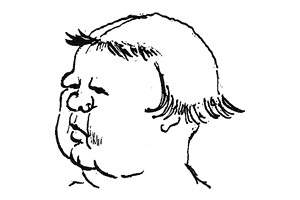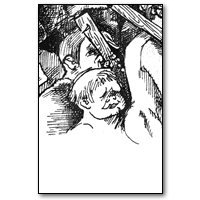Saint Fidgeta, virgin and martyr, is the patroness of nervous and unmanageable children (Saint Fidgeta and Other Parodies; 11-2).
Biography
Born in 482 in ancient Gaul, the daughter of Christian parents lived life that was "rather dull" until her father and mother were killed by a foraging band of Avars. Fidgeta was sent to live with her pagan uncle and attended a pagan grammar school where her beliefs were subject to frequent ridicule. She died in 489 at the hand of her teacher, having been slapped to death after extreme fidgeting in a desire to attend Mass.
The following year, in 490, she was canonized (presumably by Pope Felix III).
Post-canonization
Fidgettine apparitions

Saint Fidgeta
A Fidgettine apparition is a supernatural appearance by Saint Fidgeta. A few of these have been documented:
- During an attack in the 7th Century against the Byzantine city of Ud, Persian Emperor Tissaphernes encountered a Fidgettine apparition that caused his army to flee (658).
- Scintilla Sforza was witness to an apparition in 13th Century Italy. On the spot of the apparition she built Santa Fidgeta and founded the Order of Faithful Fidgettines (1272).
- During the 15th Century Turkish siege of Pinsk, Fidgeta appeared as a fluffy, pink cloud[comments 1] that induced uneasiness in the invading army (1450).
In Art
Symbols of Fidgeta in art include the red slap mark on the cheek[comments 2], the Scholar's pen, and the virgin's girdle. Early representation is rare because Byzantine art does not allow the depiction of a restless saint. Representation includes:
- Icon of Saint Fidgeta, Studium, Constantinople (not confirmed)
- Apotheosis of Saint Fidgeta
- Saint Fidgeta Chastised by Saint Jerome
- Saint Fidgeta in Ecstasy
In Prayer
- Litany of Saint Fidgeta
- Prayer Against Enemies
- Prayer for Relief from Uneasiness
Inspiration
Fidgeting, which was first attested as a verb in the 1670s[1], is the art of wiggling or twitching because of uneasiness[2] and is not an uncommon ailment, especially for a child. More so, especially for a child sitting through a long-winded sermon or scripture lesson in church who has something far more exciting on his or her mind. One can easily picture a young John Bellairs – his mind on baseball or tin soldiers or books – fidgeting away in the pew of Saint Mary’s Catholic Church in Marshall as a way to get through the never-ending Mass, Latin prayers, and whatever it was Father George Higgens talked about from behind the altar. It's not a far cry from seeing Bellairs in school and being reprimanded by the sister teachers to get him to sit still.
One hardly outgrows the ailment as an adult, as noted shortly after the book was published:
"Those who know Mr. Bellairs are often aware of the spiritual presence of the saint as they see him fidgeting about.[3]"
As a character, Saint Fidgeta can date her origins back to the early 1960s, somewhere between 1961 and 1963. Bellairs was living in Chicago and working on post-graduate work at the University of Chicago. During social events with friends Bellairs was elicited to share stories, with one about the patron saint of the frequently-encountered but seldom-praised sensation of twitching and moving. Saint Fidgeta was born.
After one such party in early 1963, Dale and Marilyn Fitschen discussed the story's popularity and suggested to Bellairs that he put the story down in writing and for possible publication. A skeptical yet intrigued Bellairs moved to Winona, Minnesota, later that year, while Marilyn kept up her doodling in Chicago. The drawings finally prompted Bellairs to commit the story to paper. Manuscripts were submitted to the Catholic literary journal, The Critic, and "Saint Fidgeta: Her Life and Amazing Times" was printed in the June-July 1965 issue. A year later Macmillan publishing company contacted Bellairs with interest in publishing the story of Saint Fidgeta in book form. Bellairs complied – adding ten-or-twelve stories to accompany the original piece – and Saint Fidgeta and Other Parodies was published in 1966.
Later Visions

Saint Fidgeta in the parade of former flimsies.

Saint Fidgeta fidget spinner, for restless souls twitching and twisting during the sermon.
The character makes a cameo appearance as a former flimsy in The Pedant and the Shuffly. In 2008, Saint Fidgeta appeared across the bottom of the outdoor mural dedicated to Bellairs painted by Massachusetts-based artist Sheila Foley; the mural is on display in downtown Haverhill.
Comments
- ↑ Clouds appear pink – or red or orange – usually at sunrise or sunset when they reflect the long, un-scattered rays of the sun. Another prominent “pink cloud” is the one associated with alcoholics and addicts; a "temporary artificial euphoria."
- ↑ We doubt a connection but the red hand mark brings to mind the Red Hand of Ulster, a heraldic symbol to denote the Irish province of Ulster.
Reference
- ↑ Online Etymology Dictionary
- ↑ Wiktionary: Fidget
- ↑ "Church scholar Hall on St. Fidgeta Question." Robert Hall. The Excalibur, November 7, 1966.
| Saint Fidgeta and Other Parodies | |
|---|---|
